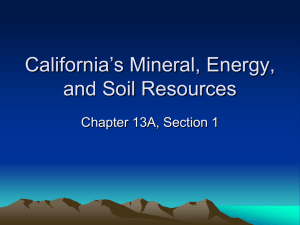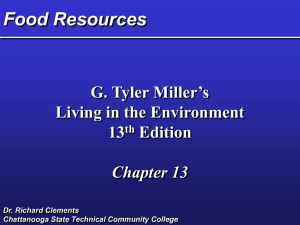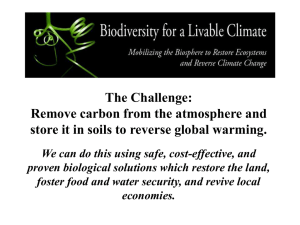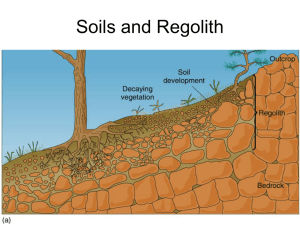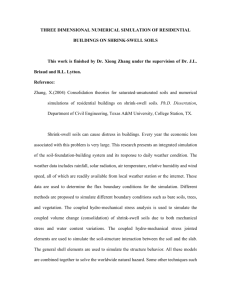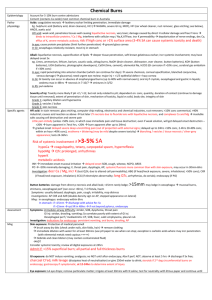Biogeochemistry of Trace elements
advertisement
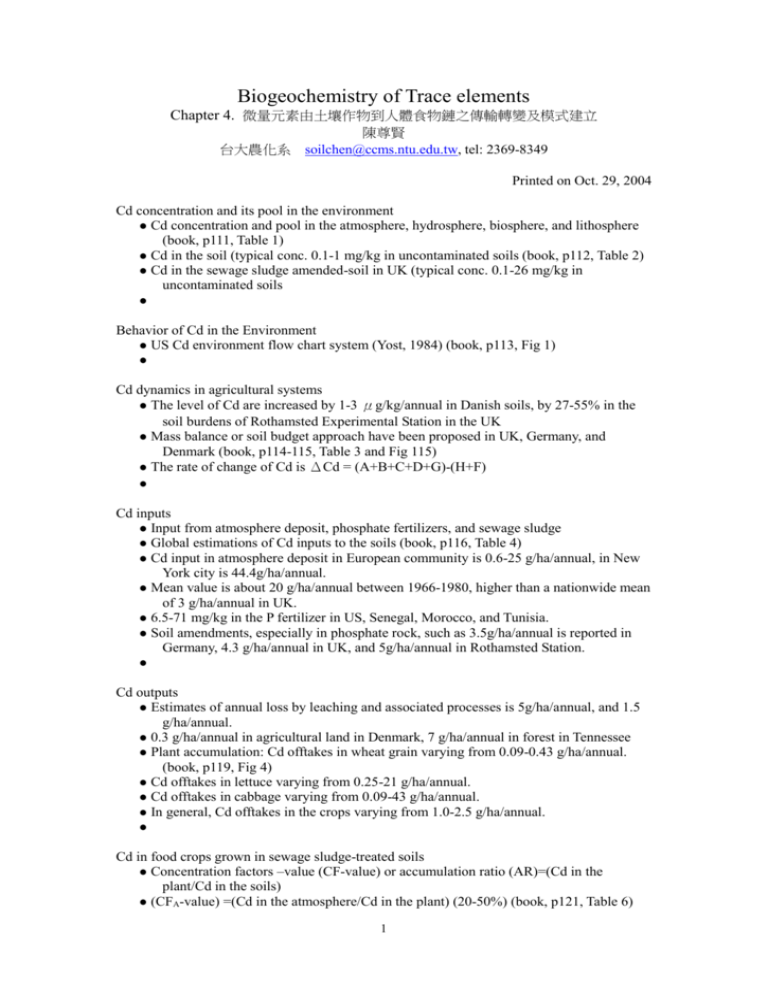
Biogeochemistry of Trace elements Chapter 4. 微量元素由土壤作物到人體食物鏈之傳輸轉變及模式建立 台大農化系 陳尊賢 soilchen@ccms.ntu.edu.tw, tel: 2369-8349 Printed on Oct. 29, 2004 Cd concentration and its pool in the environment Cd concentration and pool in the atmosphere, hydrosphere, biosphere, and lithosphere (book, p111, Table 1) Cd in the soil (typical conc. 0.1-1 mg/kg in uncontaminated soils (book, p112, Table 2) Cd in the sewage sludge amended-soil in UK (typical conc. 0.1-26 mg/kg in uncontaminated soils Behavior of Cd in the Environment US Cd environment flow chart system (Yost, 1984) (book, p113, Fig 1) Cd dynamics in agricultural systems The level of Cd are increased by 1-3 μg/kg/annual in Danish soils, by 27-55% in the soil burdens of Rothamsted Experimental Station in the UK Mass balance or soil budget approach have been proposed in UK, Germany, and Denmark (book, p114-115, Table 3 and Fig 115) The rate of change of Cd is ΔCd = (A+B+C+D+G)-(H+F) Cd inputs Input from atmosphere deposit, phosphate fertilizers, and sewage sludge Global estimations of Cd inputs to the soils (book, p116, Table 4) Cd input in atmosphere deposit in European community is 0.6-25 g/ha/annual, in New York city is 44.4g/ha/annual. Mean value is about 20 g/ha/annual between 1966-1980, higher than a nationwide mean of 3 g/ha/annual in UK. 6.5-71 mg/kg in the P fertilizer in US, Senegal, Morocco, and Tunisia. Soil amendments, especially in phosphate rock, such as 3.5g/ha/annual is reported in Germany, 4.3 g/ha/annual in UK, and 5g/ha/annual in Rothamsted Station. Cd outputs Estimates of annual loss by leaching and associated processes is 5g/ha/annual, and 1.5 g/ha/annual. 0.3 g/ha/annual in agricultural land in Denmark, 7 g/ha/annual in forest in Tennessee Plant accumulation: Cd offtakes in wheat grain varying from 0.09-0.43 g/ha/annual. (book, p119, Fig 4) Cd offtakes in lettuce varying from 0.25-21 g/ha/annual. Cd offtakes in cabbage varying from 0.09-43 g/ha/annual. In general, Cd offtakes in the crops varying from 1.0-2.5 g/ha/annual. Cd in food crops grown in sewage sludge-treated soils Concentration factors –value (CF-value) or accumulation ratio (AR)=(Cd in the plant/Cd in the soils) (CFA-value) =(Cd in the atmosphere/Cd in the plant) (20-50%) (book, p121, Table 6) 1 Cd conc. in different plants grown under same soil condition, ranging from 0.05-0.5 mg Cd/kg DW (book, p121, Fig 5) Mean Cd conc. in potato tubers (0.06-0.12 mg Cd/kg DWT) (book, p122, Table 7) Mean Cd conc. in cereal grains (0.004-0.75 mg Cd/kg DWT) (book, p123, Table 8) Mean Cd conc. in edible comp of food crop (book, p124, Table 9) Roots > stem and leaves > tubers or grains (book, p125, Fig 6). Soil factors affecting Cd bioavailability Monovariate: Log plant Cd = a + b log Soil Cd (book, p125) Liming affecting on the reduce the bioavailability: 43% for cabbage, 41% for lettuce. Multivariate equations: (book, p127) Temporal changes in crop Cd concentrations Cd conc. changes in 6 years tests of application 10 and 100 tons/ha/annual of swage sludge (book, p129, Fig 7) Prediction concentration of Cd in crop Log P = a + b log Cd DTPA Soil extractants: DTPA, EDTA, 0.1M sodium nitrate, 0.05M calcium chloride. Dietary exposure to Cd from food crops Kidney is the main target organ for Cd residue time for >30 yrs. Provisional tolerable weekly intake (PTWI) of 400-500 μg/ from diets per person is acceptable. Acceptable daily intake (ADI) for Cd in Japan is 325 μg/person/day, is 1μg/kg body/per day. Cd conc. in foods and total diet studies National means of Cd dietary exposure (0.1-0.4 mf Cd/week/p) (book, p135, Table 11). Cd exposure profile in different countries (15-50 μg/ day/person) (book, p136, Table 12). 30-40% of the total dietary exposure of Cd is from cereal consumption in European community. Assessment Models of Cd exposure Four methods of exposure assessment: standard or total diet study, duplicate meal, fecal analysis, and diary studies. Case study in UK (book, p139, Table 13) Maximum permissible conc. (mg/kg DWT) in food (Book, p140, Table 14). Cd transfers in agroecosystem (book, p141, Fig. 9) USEPA WHO suggested 525μg of PTWI for dietary exposure, or 70μg/day. Speciation of Cd in foods 2




